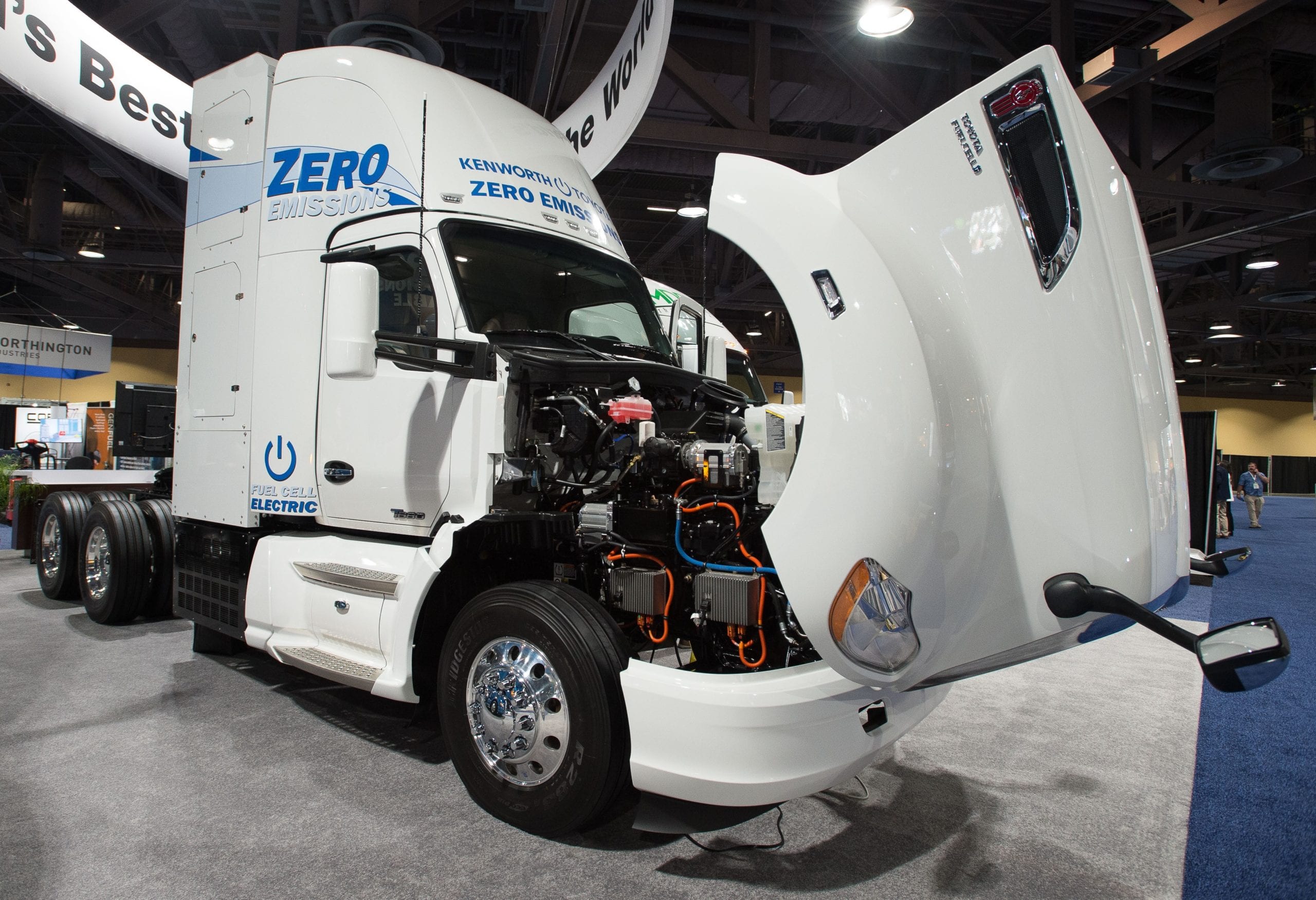ACT NEWS 101 is a series of articles breaking down the basics of clean fuels, transportation technologies, funding programs, and other emerging trends.
Imagine powering a vehicle with a technology that uses an abundant resource and produces nothing more than water vapor and warm air in return. Hydrogen fuel cell electric vehicles (HFCEV) make this futuristic-sounding scenario a quickly approaching reality. Producing zero harmful air pollutants from tailpipe emissions and providing clean and efficient transportation, can fuel cells transform the way we move people and transport our goods?
How Does a Fuel Cell Power a Vehicle?
HFCEVs use hydrogen gas to power a vehicle’s electric motor which is why fuel cell vehicles are considered electric vehicles. The only difference between a battery electric vehicle and a fuel cell electric vehicle is how electricity is stored and delivered to the motor.
Instead of a tank filled with gasoline or diesel, HFCEVs carry an onboard hydrogen tank, filled with compressed hydrogen gas. Hydrogen flows from the onboard tank to the vehicle’s fuel cell stack, the component capable of converting energy, stored as hydrogen, to electricity.
Instead of a tank filled with gasoline or diesel, HFCEVs carry an onboard hydrogen tank, filled with compressed hydrogen gas.
Refueling a HFCEV with hydrogen is similar to fueling a conventional vehicle with gasoline or diesel. Pressurized hydrogen gas is delivered to a hydrogen station, enabling drivers to refuel a HFCEV with a dispenser and nozzle, comparable to a dispenser at a gas station.
Benefits of Fuel Cell Vehicles
While both conventional vehicles and fuel cell vehicles consume fuel, conventional vehicles powered by gasoline produce harmful and toxic tailpipe emissions including greenhouse gases, NOx emissions, and particulate matter. HFCEVs are zero emission vehicles because they produce no tailpipe emissions and only emit water vapor and air as a byproduct. The total emissions of HFCEVs, however, depend on how the hydrogen fuel was made and delivered.
Similar to conventional vehicles, HFCEVs can be refueled at a fueling station in about five minutes and have driving ranges over 250 miles. Although HFCEVs are considered electric vehicles, unlike battery electric vehicles, HFCEVs do not need to be plugged in to an electric outlet to be recharged.
HFCEVs are zero emission vehicles because they produce no tailpipe emissions and only emit water vapor and air as a byproduct.
A History of Fuel Cells
Today’s HFCEVs are made possible by technology initially developed over a hundred years ago. In 1889, scientists Ludwig Mol and Charles Langer, improving on even earlier fuel cell models, first coined the term “fuel cell” and developed the world’s first working fuel cell. In 1932, engineer Francis Thomas Bacon (of “knowledge is power” fame), developed innovations to the existing fuel cell technology which had used expensive platinum and corrosive sulfuric acid, improving the technology’s components and modernizing fuel cells as they are utilized today.
Fuel Cell Technology
Regardless of the type of fuel cell technology being used—alkaline, phosphoric acid, or solid oxide—modern fuel cells are organized as stacks, optimizing the technology’s size and efficiency.
What makes fuel cells promising for transportation is the ability to produce power from the earth’s most abundant resource as well as their ability to produce a large, stable energy supply that meets current diesel vehicle range requirements—while creating zero harmful tailpipe emissions.
The most common fuel cell type used in vehicles is the Polymer Electrolyte Membrane (PEM). In addition to the technology itself, PEM fuel cells only require hydrogen, oxygen from the air, and water to operate. This technology utilizes a platinum plate to ionize hydrogen particles. Ionizing a hydrogen atom removes, or adds, electrons to form a positive or negative charge.
In the PEM, on one end, hydrogen enters through the anode. The platinum plates, in combination with a catalyst to speed up the reaction, splits the hydrogen from its negatively charged electrons, ionizing the hydrogen as positively charged. The platinum membrane then allows the positive hydrogen ions to pass through to the cathode. The negatively charged electrons continue to pass through the external circuit of the cathode, then return to the unit, creating a circular electrical current. On the opposite end, oxygen (O2) atoms enter the cathode, and the electrons stripped from the oxygen (O) are combined with the positively charged hydrogen atoms (H2) to create water (H2O) outside of the cell.
Looking to the Future
While the mechanics of a fuel cell are well understood and have been studied for some time, the cost of implementing fuel cell technology for transportation has been a persistent barrier to widespread application. However, fuel cell technology is now on its way to commercial viability in certain transportation sectors.
The amount of direct current (DC) energy a fuel cell generates depends on the size and surface area of the cell itself. Fuel cells are often stacked, or connected, as the power required is often higher than what a single fuel cell is capable of supplying. Creating a lightweight and affordable fuel cell capable of fueling a medium- or heavy-duty truck transporting goods, along with the necessary fueling infrastructure required to fuel the vehicle, was once considered an enormous challenge. Now, vehicle manufacturers are developing, testing, and deploying zero emission fuel cell electric vehicles in applications as demanding as heavy-duty operations.
Fuel cells are often stacked, or connected, as the power required is often higher than what a single fuel cell is capable of supplying.
Another obstacle to widespread deployment and adoption of fuel cell vehicle technology remains the lack of widescale accessible hydrogen infrastructure in the form of hydrogen fueling stations.
Like any vehicle, HFCEVs must also take strict safety precautions into account. HFCEVs have specific safety systems that include hydrogen sensors, temperature activated pressure relief devices, and ground-fault systems that isolate the fuel from electricity when necessary.
As HFCEVs continue to be developed and deployed, and as hydrogen fueling stations grow in number, we can envision how fuel cells may become an integral part of a future zero emission transportation ecosystem.



